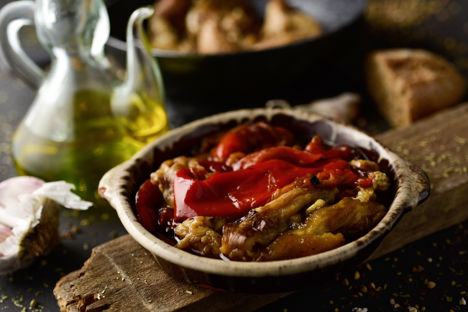
8 must-try dishes from Catalonia
Spain’s most beautiful region is also home to some of its finest dishes and ingredients – get to know its local specialities for the next time you visit the area.
8 must-try dishes from Catalonia
Spain’s most beautiful region is also home to some of its finest dishes and ingredients – get to know its local specialities for the next time you visit the area.
Much like Italy, India or China, Spain is a country with very distinct regions – and the food found in each area is incredibly unique. Catalonia, in the northeast, is where you’ll find some of the country’s most celebrated dishes, served in the tapas bars of Barcelona, family-run restaurants in Girona and in home kitchens throughout the beautiful countryside. It’s also home to sixty-five Michelin-starred restaurants, putting Catalonia at the forefront of Europe’s fine dining scene. Whilst popular Spanish dishes like paella and products like chorizo are always present (particularly in big cities and touristic areas), Catalonians make the most of their own produce and turn it into simple, fantastic plates of food.
Whether you’re planning to visit Catalonia or just want to recreate the flavours of the region in your own home, these are the dishes you need to try to get a real sense of the local cuisine. The ethos of Catalonian food is simple – take the best ingredients and allow their natural flavour to shine through.
1. Pa de coca
The ultimate Catalan sandwich (known as an entrepà) should definitely be made with Catalonia’s very own flatbread: pa de coca. The bread can be toasted or not, but it must be rubbed with tomatoes (beware of the bars where the bread is simply topped with blended tomatoes!) and dressed with extra virgin olive oil, sprinkled with a little salt and then layered with slices of fuet, a thin cured sausage flavoured with pepper and garlic, llonganissa, bull blanc, or any other iconic cured meats from the region.
2. Peus de porc
Pig trotters are woefully underused in the UK, but in Catalonia they’re celebrated for their rich, piggy flavour. The most common way of cooking them is in a stew, with plenty of potatoes, garlic, parsley and breadcrumbs. Everything is slowly cooked until the meat becomes meltingly tender, with some recipes calling for almonds, red peppers, raisins, wine or chilli to help flavour the sauce.
3. Patates braves
Probably one of the most popular Spanish dishes all over the world, patatas bravas (known in Catalonia as patates braves) is a simple tapas dish which has its origin in 1960s Madrid. Patatas bravas – essentially potatoes in tomato sauce – are given a flavourful twist in Catalonia with the addition of aioli (allioli). White potatoes are boiled and then fried until crisp, before being smothered in a thick tomato sauce flavoured with garlic, tabasco and a little paprika (hence the epithet 'bravas', meaning spicy). The whole dish is then drizzled with creamy aioli and eaten warm.
4. Bacallà gratinat
Catalans love their fish, and one of the tastiest ways they prepare fresh cod is with this deliciously simple dish. A fresh, pearly white fillet of cod is smothered in creamy, garlicky aioli, which is then put under the grill until the sauce develops a golden brown crust. Anything covered in aioli tends to be pretty tasty, but cooking the sauce until it’s firm and bubbling takes this dish to a whole other level.
5. Fesols amb botifarra de perol
Fesols de Santa Pau are a type of small bean grown in La Garrotxa and botifarra de perol is a Catalonian sausage made of the pig's head, heart, kidney, rind and blood, which is then cooked in a terracota pot or perol.
The beans aren’t always fesols de Santa Pau; many cooks like to use faves (fava beans), fesols menuts (from L'Empordà) or Mongeta del ganxet DOP beans, which are like smaller, more flavourful butterbeans. It’s really easy to cook – simply fry the cooked beans in garlic and oil, add the shredded botifarra de perol, then season. Some Catalonians like to add some parsley at the end, too.
6. Esqueixada
Combining shredded salt cod, tomatoes, peppers, olives and olive oil, esqueixada is the ultimate summertime salad. The name comes from the Catalan word esqueixar, which means to tear or shred. The salted cod is soaked in water before shredding and marinated in plenty of olive oil, then gently tossed with the other ingredients alongside a little sherry vinegar.
7. Fricandó
This hearty, filling veal and mushroom stew is nice and simple, allowing the flavours of the wild mushrooms to shine through. Typically eaten during autumn, when the mushrooms are in season (St George’s or Fairy Ring mushrooms are traditionally used), dried can be used too. What makes this dish quintessentially Catalan is the inclusion of garlic, stale bread or biscuits, parsley and almonds in a picada, which is used to thicken the white wine and tomato sauce.
8. Escalivada
A combination of aubergines, peppers and large onions seasoned with plenty of high-quality olive oil and salt. The beauty of this dish is in the cooking method – the vegetables are grilled on an open flame until they’re blackened and charred, at which point they’re left to cool and peeled and cut into strips. They have a smoky flavour which, when combined with fruity, peppery olive oil, is delicious. Serve on its own as a tapa, on bread or with cheeses and cured meats.


